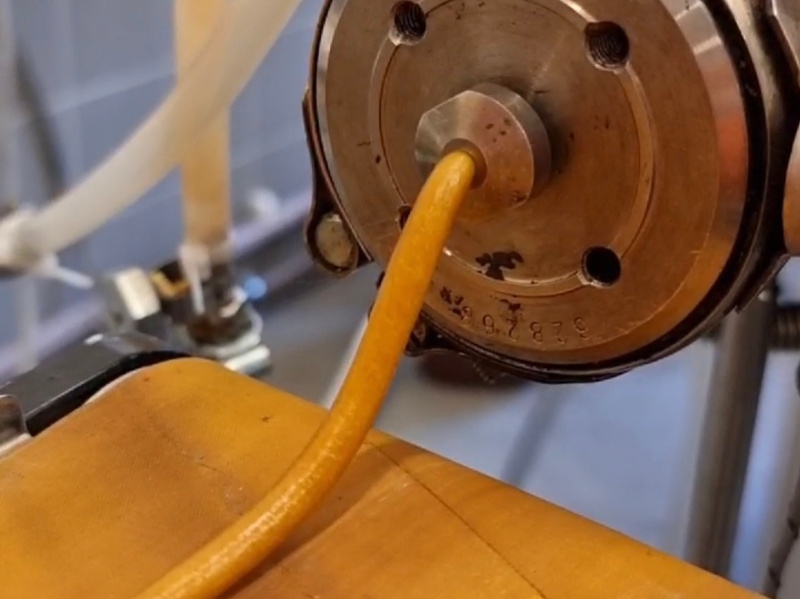The course provides an overview of the major industrial processing routes for thermoplastics, thermosets and rubbers, and describes how these can be used to convert polymers into products as related to the macromolecular structures of the polymers. The polymer categories are described to extents that represent their processing abundance in the society. Melt processing of the thermoplastics is described in terms of mechanical and physical behaviors as related to processing parameters, including: melting, rheology and viscosity, molecular orientation, crystal formation/growth and the relevance of post processing methods. The industrial techniques extrusion, injection molding, hot forming, film blowing and calendaring are discussed in detail. The techniques are exemplified by laboratory exercises, including extrusion and injection molding of some of the most common thermoplastics. Thermosetting polymers are introduced as a polymer category with cross-linked polymer chains and described as a matrix material for fiber reinforced polymer structures. Thermosetting polymer composite fiber laminates reviewed and different fiber impregnation techniques are discussed (for epoxies, polyesters and vinyl esters) as well as high and low-temperature curing conditions. An introduction into the most common industrial methods to improve composite fiber/filler interfaces is given, e.g. for improved mechanical properties. Cross-linked elastomers (rubbers) are presented and the main types are discussed in detail, which is followed by a laboratory exercise introducing the students to natural rubber vulcanization, A part of the course consists of student projects and demands that the student identifies the polymer processing techniques for a known product, identifies its constituent materials, and in group/individually discuss possible improvements in a presentation. The aim is that the student should be able to critically analyze and motivate the best selection of materials as related to its demands and production cost, with possible improvements. The overall learning goal with the course is that the students have acquired a general knowledge of the utilization of engineering thermoplastics, thermosets and rubber-like materials used in the diverse polymer processing industry. Each lecture is accompanied with 8-12 more specific learning goals to facilitate repetition of the lectured course content.
KF2505 Polymer Materials Processing 7.5 credits

The course provides an overview of the processing routes for thermoplastics, thermosets, and rubbers and describes how these can convert into products with consideration to the macromolecular structures of the polymers. The categories are described to extents that are representing their processing abundance in society.
Melt processing of plastics is described in terms of the mechanical and physical behaviors related to processing parameters, including; melting, rheology and viscosity, molecular orientation, crystal formation/growth, and crystallization relevance. The industrial techniques extrusion, injection molding, hot forming, film blowing, and calendaring are discussed in detail. The mechanical properties are reviewed in terms of viscoelasticity, plasticity, deformation rates, and effects of temperatures (a consequence of processing parameters). The techniques are shown in laboratory exercises, including extrusion and injection molding of some of the most common thermoplastics.
Thermosetting polymers are introduced as a polymer category with cross-linked polymer chains and described as a matrix material for fiber-reinforced polymer structures. Laminates and different impregnation techniques with thermosetting polymers (epoxies, polyesters, and vinyl esters) are reviewed. An introduction to the most common industrial methods to improve composite fiber/filler interfaces is given, e.g., for improved mechanical properties.
Elastomers (rubbers) are presented, and the main types are discussed in detail, followed by a laboratory exercise introducing the students to natural rubber vulcanization.
A part of the course consists of projects. It concerns the selection of polymer materials iwhere the students analyze its constituent materials as related to its applied processing environment. The aim is to investigate the processing of the materials as related to material specific demands (and production costs), and to discuss possible improvements or drawbacks.
Information per course offering
Choose semester and course offering to see current information and more about the course, such as course syllabus, study period, and application information.
Course syllabus as PDF
Please note: all information from the Course syllabus is available on this page in an accessible format.
Course syllabus KF2505 (Autumn 2024–)Content and learning outcomes
Course contents
Intended learning outcomes
After completing the course the student should be able to:
- Be able to describe different processing strategies of polymers with different characteristics, related to the possibility to use them in continuous or intermittent polymer processing.
- Be able to relate the processing conditions to specific processing equipment, extruders, injection molding machines, calendaring equipment, etc. used to produce commonly encountered polymer products in the society.
- Be able to carry out the basics in processing of thermosets, thermoplastics and elastomeric materials in a processing laboratory.
- Be able to make use of polymer crystals in thermoplastics and describe to which extent crystallization can be used to improve the performance of the polymer products.
Literature and preparations
Specific prerequisites
Completed degree project 15 credits, 50 credits in chemistry or chemical engineering, 20 credits in mathematics, numerical analysis and/or data science. English B/6.
Literature
Examination and completion
Grading scale
Examination
- TEN1 - Written exam, 4.5 credits, grading scale: A, B, C, D, E, FX, F
- PROA - Project, 1.5 credits, grading scale: P, F
- LABA - Laboratory course, 1.5 credits, grading scale: P, F
Based on recommendation from KTH’s coordinator for disabilities, the examiner will decide how to adapt an examination for students with documented disability.
The examiner may apply another examination format when re-examining individual students.
If the course is discontinued, students may request to be examined during the following two academic years.
Other requirements for final grade
Active participation in all compulsory activities as specified in Course information.
Examiner
Ethical approach
- All members of a group are responsible for the group's work.
- In any assessment, every student shall honestly disclose any help received and sources used.
- In an oral assessment, every student shall be able to present and answer questions about the entire assignment and solution.